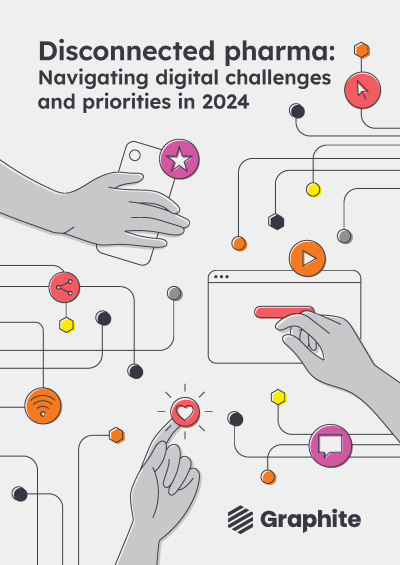
Is trust the key factor in digital HCP engagement? Explore this in our latest whitepaper
Are you doing enough to build a foundation of trust via your digital platforms and content?
This week, we're excited to release our latest whitepaper.
Based on research with HCPs in the UK, USA and France, we shed light on their perceptions of pharma-owned digital channels, and what organisations should be prioritising in order to build trust, strengthen relationships and drive engagement.
- HCP Engagement
- Pharmaceutical
- Digital Strategy
Connectivity underpins innovation and efficiency, enabling improved outcomes for patients and HCPs.
Our latest research reveals the need for increased connection across the pharma sector — linking data with actionable insights, joining up internal teams, improving interactions between end users and providers, connecting digital systems and platforms, and aligning long-term goals with short-term priorities.
Drawing on the survey data, along with opinions from expert contributors and Graphite's own sector experience, we explore how pharma teams can overcome challenges to achieve success with their digital solutions and strategies.
Based on first-hand insight from pharma leaders working within Commercial, Medical, Marketing and Digital roles across the USA and Europe.
Digital focus areas, challenges and investment 2024
There are no signs that investment in digital is slowing down, despite the rate of digital transformation and spending across the sector in recent years — with 51% of respondents planning to increase spending, and no one planning to reduce it. This is a positive sign that existing digital initiatives will either be sustained or increased and shows a commitment to thinking long-term and pursuing innovation.
When we asked participants about the biggest internal barriers to digital transformation and adoption that they face, 36% put this down to budgets, insufficient investment in digital products and strategies, or people being unrealistic about costs.
To secure further investment, it will be crucial to demonstrate the ROI of digital solutions and initiatives, which can sometimes prove challenging within pharma. Having a clear understanding of the “why”
behind all projects from the outset will help set meaningful objectives
and KPIs that can be used to demonstrate value — from both a business
and customer perspective. There needs to be a clear connection
between business goals and outcomes.
“Pharma can demonstrate the ROI of digital solutions by leveraging data analytics to show tangible improvements in efficiency, KPIs, and/or cost savings.”
Nordic Digital Director, Novartis
Digital decision-making and customer insight
Our research found that digital decision-making in pharma is increasingly based on first-hand customer insight — 25% said that all their decisions are based on first-hand customer insights, and 63% said that most of their decisions were based on this. However, teams are relying heavily on research methods such as focus groups and surveys which can be flawed and lack depth in terms of the insight they provide.
Although most organisations are basing decision-making on customer
insight, acquiring this information can prove challenging. Participants
spoke about difficulties in accessing or engaging patients and HCPs
for digital research purposes, as well as interpreting user feedback to
take action.
To overcome these challenges, there are a few things pharma teams can do. Firstly, clarity around research purposes and requirements is crucial — people need to understand what’s needed of them, how it will benefit them in the long run, and to feel reassured about confidentiality and privacy when sharing their views.
Secondly, practical incentivisation in the form of financial reimbursement for time spent sharing feedback is important and demonstrates respect for your customers and their time.
Finally, working with an external research partner who can approach projects objectively, and has experience in turning raw findings into actionable, prioritised insights will increase the chances of success.
“In the near term the most important thing pharma companies can do to improve digital experiences for HCPs and Patients is RESEARCH. Simply put – ask them what their biggest challenges are and investigate how willing they are to use digital solutions from pharma companies to solve those problems. The more we use Digital to solve HCP and Patient challenges vs using digital to disseminate campaign messages the more we can improve outcomes and drive value.”
Top 10 Global Pharma Org
Internal structures, silos and mindsets
Internal structures, mindset and culture continue to prove to be significant barriers for digital success within pharma. There is a need for organisational change management to foster stronger connection and collaboration.
58% of respondents believe that internal structures within their organisations create the biggest barriers to digital transformation and adoption.
38% said the biggest barrier to digital transformation their organisation faces is internal mindset and culture, citing a lack of engagement in digital due to risk aversion and outdated thinking.
It’s not possible to change the culture of an organisation overnight, and the reasons for being naturally cautious within a highly regulated sector are clear, but there’s scope to evolve ways of working and thinking to improve digital impact. This change comes from the top and must be embraced and spearheaded by senior stakeholders, whose leadership is essential for internal alignment and collaboration.
Data, metrics and KPIs
Pharma teams sit on vast amounts of data but struggle to know how to use it meaningfully to inform their digital strategies and approaches. By connecting the dots between data sources and making the insight actionable there is huge potential for improving customer experiences.
When we asked which factor would have the biggest impact on enabling better digital experiences for their customers, 49% said they needed to learn how to better use data to offer a more personalised experience, and 51% said that enhancing user experiences across all digital platforms would be key. User experience and data-informed personalisation go hand-in-hand — the more we can tailor experiences to users on an individual basis, the better the user experience we can offer.
Data management and utilisation were also found to underpin omnichannel success. 77% of respondents said that their omnichannel strategies had little to no impact on customer engagement, and that they have experienced many challenges around implementation and enablement. The top challenges mentioned were around data security and privacy, and the need for better data management and utilisation.
Looking to the future: Unlocking innovation and disruption
Data security and privacy is a key priority for those working within the pharma sector, who are asking — how can we advance our digital strategies and become more data-driven, whilst keeping vast amounts of customer data secure and meeting ethical and regulatory standards?
When we asked participants which factor they think will be most important for driving digital innovation and disruption in the next 5 years, the top response was ensuring robust data security and privacy measures (37%).
The right data strategy sets the foundation for delivering intelligent and personalised user experiences across multiple channels. This is no small feat and requires the necessary planning, technology, systems and resources.
“Data security is vital, but it must be internalised, not passed to someone else. It should be a deep-seated discipline if it’s to enable the industry’s capacity for innovation. Then regulations don’t just become constraints but frameworks within which they can safely and creatively experiment – and given the myriad possibilities of this new AI-powered world, that experimentation will be really important.”
Chief Executive, Impatient Health

Download resource
Connectivity underpins innovation and efficiency, enabling improved outcomes for patients and HCPs.
Our latest research reveals the need for increased connection across the pharma sector — linking data with actionable insights, joining up internal teams, improving interactions between end users and providers, connecting digital systems and platforms, and aligning long-term goals with short-term priorities.
Drawing on the survey data, along with opinions from expert contributors and Graphite's own sector experience, we explore how pharma teams can overcome challenges to achieve success with their digital solutions and strategies.
Based on first-hand insight from pharma leaders working within Commercial, Medical, Marketing and Digital roles across the USA and Europe.
Want to read more on creating successful digital products within pharma?


How user research will help you create better digital products, whatever stage you’re at
- Healthcare
- Pharmaceutical
- User research
